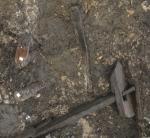Summary (English)
This season, work continued in sector 2, the new area opened in 2016. Last year’s excavations had already shown that sector 2 could be divided into an eastern strip, very similar to sector 1, still part of the heavily anthropised area of the village, although it already presented some elements of interaction with the lake. The western part of the sector was very different and much less anthropised, with substantial peaty stratigraphic contexts, mainly of natural origin. Between these areas was a strip on a NW-SE alignment characterised by extensive lenses of dumped material, in part with vegetal components, in part with clay components, interlocked in a complex way that formed a sort of cordon. This situation probably marked the limit on the lakeside of the palafitte village. The 2017 season mainly concentrated on the excavation of the levels forming this cordon in an attempt to define their complex stratigraphic relationships and the nature of this type of deposit and of the silt levels rich in materials present in the pertinent parts of the most anthropised area.
A new timber element was found precisely at the edge of this area, close to the line of dumps, within the silt-peaty layer (US 479-9). It was the terminal part of a horizontal beam (EL 995/1074) originally with at least three quadrangular holes, which was found with a small tapering beam still fixed in one of the holes (EL 1092). These elements were probably part of a series of structural elements including the two long multi-holed beams (ELL 1104 and 1205) found during the last years, which belonged to the first palafitte of Lucone D, which then went out of use during the first phases of the second village.A fragment of a small plank with a hole in the end, similar to two planks found in the levels relating to a fire in sector 1, was found near the terminal of beam EL 1074 together with a large basket collapsed on one side.
This season’s excavations also produced abundant finds. Pottery was predominant, with numerous intact, almost intact, or completely reconstructable vessels. There were a modest number of terracotta spindle whorls and also stone tools. There were few flint artefacts, mainly scrapers or sickle blades, but also some rare examples of end-scrapers. A nice example of a brassard d’archer in levigated stone is worthy of note. Several punches made of bone-horn and two large rings made of deer horn, probably ornamental elements like the shell pendants, segments of dentalium shells and beads made from Staphylea _pinnata seeds. Among the most interesting finds are the wooden implements, such as an axe handle, which still bears the marks of leather cords, a probable agricultural tool traditionally defined as a pseudo-hoe, a wooden hand hammer, and the above-mentioned basket made of woven twigs.
- Marco Baioni- Museo di Gavardo
Director
Team
- Claudia Mangani
- Cristiano Nicosia
- Elisa Zentilini - Università di Verona
- Fabio Bona - Dipartimento di Scienze della Terra ‘A.Desio’, Università degli Studi di Milano
- Flavio Redolfi Riva
- Michele Colosio
- Nicoletta Martinelli (Dendrodata – Verona)
- Renata Perego
- Cesare Ravazzi (CNR – IDPA – Milano)
- Enrico Abastanotti, Alice Bazzoli, Tommaso Candido, Debora Gothier, Stefano Vetturi, Pietro Castagnero
- Giorgio Garatti, Emanuele Saletta, Barbara Valdinoci
- Angelo Lando
- Gabriele Bocchio, Angelo Lando, Francesco Maioli, Ivan Bresciani, De Giuli Giambattista, Eliseo Mora, Ezio Persavalli, Piercarlo Spinelli, Manuel Vaglia, Raffaele Vaccaro
Research Body
- Museo Archeologico della Valle Sabbia - Gavardo
Funding Body
- Comune di Gavardo
- Comune di Polpenazze del Garda
- Regione Lombardia






![Download [PDF]](/excavation/skins/fasti/images/results/download_sml.png)